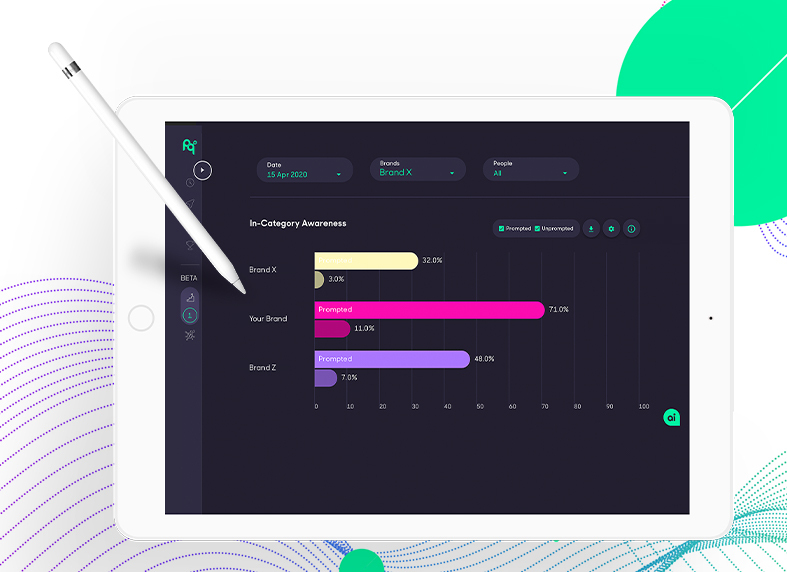Posted on April 28, 2020
Updated on March 9, 2023
3 min read time

Brand awareness is elusive – it’s how well people are able to remember or recognize brands in a variety of situations and conditions. It’s notoriously difficult to capture and to measure, and it’s driven by a number of different factors.
Brand awareness means remaining front of mind when people think about your category and marketing with long term consistency to create recognizable memory structure. Improving brand awareness requires a complicated mix of high-impact brand communications and tactical measures to ensure that people see, remember, and recognize your brand – it can be overwhelming!
So with all that you have control over, and all that you don’t, what are some of the best ways to measure brand awareness?
 1. Measure earned media
1. Measure earned media
Public relations efforts and earned media are a great way to drive awareness of your brand. Earned media is content written about you that you haven’t directly posted or paid for. It also helps you grow your brand awareness, as you are also more likely to be featured or quoted in further publications, causing a ripple effect of awareness building.
Earned media is notoriously challenging to measure earned media; some companies focus on share of voice while others prefer to focus on the reach of the publication. Both can be both a good booster and a good indicator of your brand awareness.
Diving into finer metrics can give you an even better idea of your brand awareness and reach. Get granular by tracking shares, social media engagement, and reach with every story that your brand is mentioned in for a better understanding of those who know your brand and what’s catching on.
2. Monitor website traffic
Compare and contrast direct traffic and referral traffic on your website. Direct traffic is made up of anyone that types your URL into their browser without redirecting from another website. This denotes good brand awareness overall, since people remember you enough to recall your direct website link.
Referral traffic is made up of people that have found your website from another direct links on other websites, like Facebook or a media outlet that has covered your brand. Referral traffic is good for growing brand awareness through third parties, increasing your credibility by association.
Monitor changes over time within both direct traffic and referral traffic for guidance on what works and what doesn’t.
3. Social media awareness
Similar to monitoring web traffic, having a strong social media presence is important for growing brand awareness. An active account boosts engagement and gets your brand in front of more people (when done correctly). Tagging relevant parties, posting a variety of different kinds of content, and making sure to create content that engages your audience is paramount for keeping your brand top of mind. It also creates an opportunity for your customers to contact you directly through tags, which expands your reach within their followers.
After establishing a constant cadence of a variety of different kinds of content, keeping track of engagement per post and over time is a reliable component of determining brand awareness. Be sure to measure across every active platform for the best insights on what works for your brand.
4. Track backlinks
Gaining backlinks is important for measuring your brand awareness – the more backlinks, the stronger your brand awareness. Backlinks are links from another website to your website. This website could be your home page, a landing page, or anything under the umbrella of your URL. Backlinks are usually used as a citation, such as when a website mentions your company and hyperlinks your brand name to your homepage.
A strong content strategy should have more and more people linking to your content, using backlinks to reference your thought leadership, your products, and your brand. The stronger your content strategy, the more you boost your SEO and your visibility in search engine results for stronger brand awareness. Weak content results in less backlinks, and therefore lessens brand awareness. Monitor how many backlinks you have in your arsenal; measuring these results gives insight on how to adjust your content strategy.
5. Going to the source
Another option for measuring brand awareness is by asking people directly. Depending on the size and scale of your brand, this can be done with a couple of different digital survey tools. At ProQuo AI, we do it most effectively with our new live brand awareness tracker.
At ProQuo AI, we measure brand awareness, both prompted and unprompted, live. Unprompted awareness – where people can recall the name of your brand when asked – is an indicator that your brand is top of mind within a category. Prompted awareness is when your brand is recognized within a list alongside your competitors. The awareness tracking that ProQuo AI provides allows you to understand the percentage of people who are aware of your brand both at a prompted and unprompted level. And, since we gather this data every day, you are able to see how your awareness changes over time, in conjunction with key decisions you make for your brand.
Tracking brand awareness can be nebulous at best, as well as prohibitively expensive –but it doesn’t have to be. Take a look at our awareness tracking feature, free with a ProQuo AI subscription, and learn how you can get a better idea of your own brand awareness.
Our intelligent platform will take your brand further, faster.
Don’t believe us?
© 2020-2023 ProQuo AI International
All rights reservedWebsite by Blend